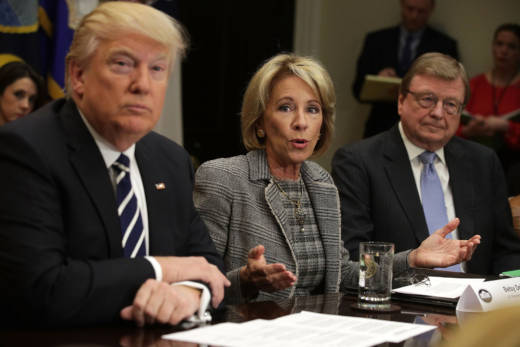Some charter school advocates in California welcome that support, while others worry Trump’s support of charters -- backed by U.S. Secretary of Education Betsy DeVos -- might prove toxic and end up bolstering local opposition to charter schools.
Will Trump give California public schools more money? Or take funding away?
Trump wants to do both.
The president's proposed 2017-18 budget calls for a historic $1.4 billion federal investment in school choice, including new money for private school vouchers and charter schools, as well as directing $1 billion to follow students to the school of their choice.
That infusion of school choice cash is far smaller than the $20 billion investment he proposed on the campaign trail, but it still represents a big shift in federal priorities.
At the same time, he’s proposing to slash federal funding for long-established after school programs, early learning initiatives and teacher preparation and retention.
Because California is one of the largest states with the most public school students, Trump's plan would result in a loss of hundreds of millions of federal dollars.
Trump also doesn't plan to increase funding for special education programs under the Individuals with Disabilities Education Act (IDEA). Special education advocates have been pushing for more federal support because special education programs are costly, forcing state and school districts to make up the difference.
Some local teachers unions say Trump wants to 'privatize' public schools. What does that mean? Will he do it?
President Trump has made it clear he wants to create a private school choice program at the federal level, which would offer American families alternatives if they don’t want to send their children to local public schools.
California’s Constitution prohibits private school choice programs. However, more than a dozen other states do support them -- the most popular programs being school vouchers and tax credit scholarships.
As such, these are the two options Trump wants to make the centerpiece of his education agenda, which is outlined in his proposed 2017-18 budget. But restructuring the country’s public school system to allow for more private school choice is likely to face legal challenges and hurdles from Democratic-controlled states.
U.S. Education Secretary Betsy DeVos has said she will not impose a federal school choice program on states, which leaves many unanswered questions.
What's the difference between a school voucher and a tax credit scholarship?
School vouchers are publicly funded coupons set aside by a state.
Qualifying families can use vouchers to pay for the private school of their choice, whether it’s a parochial or independent school. But critics point out vouchers may not cover the full cost of tuition, leaving many low-income families in a precarious position from year to year.
Critics also say vouchers rob public schools of state funding, making it difficult for them to improve the quality of education.
Tax credit scholarships on the other hand are funded through individuals and businesses who donate to nonprofits specializing in these grants. In return, those individuals and businesses get tax breaks.
Families must apply for tax credit scholarships, which can only be used at private schools that accept them.
Critics say -- much like vouchers -- tax credit scholarships don’t always cover the full cost of tuition, and the most disadvantaged families are often competing with middle class families to secure the grants.
Additionally, private schools don’t have to adhere to the same kind of accountability rules that public schools must follow -- and private schools can also be selective in who they admit.
So even if a family has secured a tax-credit scholarship, their child isn't guaranteed a seat in class.
Can I start exploring private schools in California as an option for my child?
California -- along with 35 other states -- adheres to what’s called the Blaine Amendment, a statute written into the state Constitution which sets strict limits on public dollars going to religious causes, i.e. parochial school tuition, in this instance.
As a result, the Golden State prohibits the use of tax credit scholarships or school vouchers, so families cannot leverage these options in looking for private school alternatives.
State lawmakers could adopt another statute which would override the Blaine amendment -- but that’s not likely to happen in deep-blue California which is a strong defender of its public school system.
Of course, all that could change if Trump imposes a private school choice program on states.
A recent public opinion poll found more Californians are interested in the idea of school vouchers, with roughly 60 percent of residents liking the concept.
